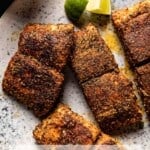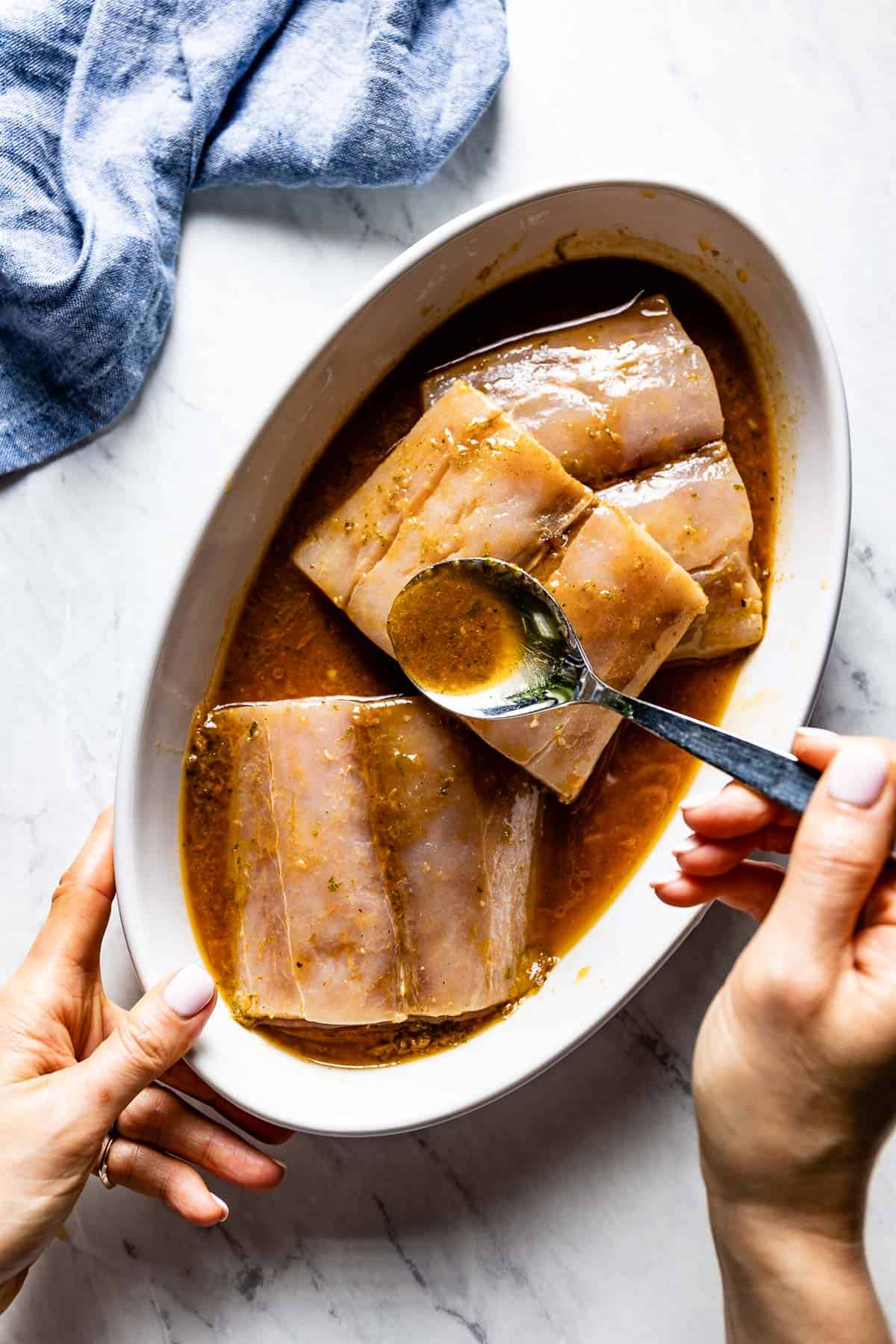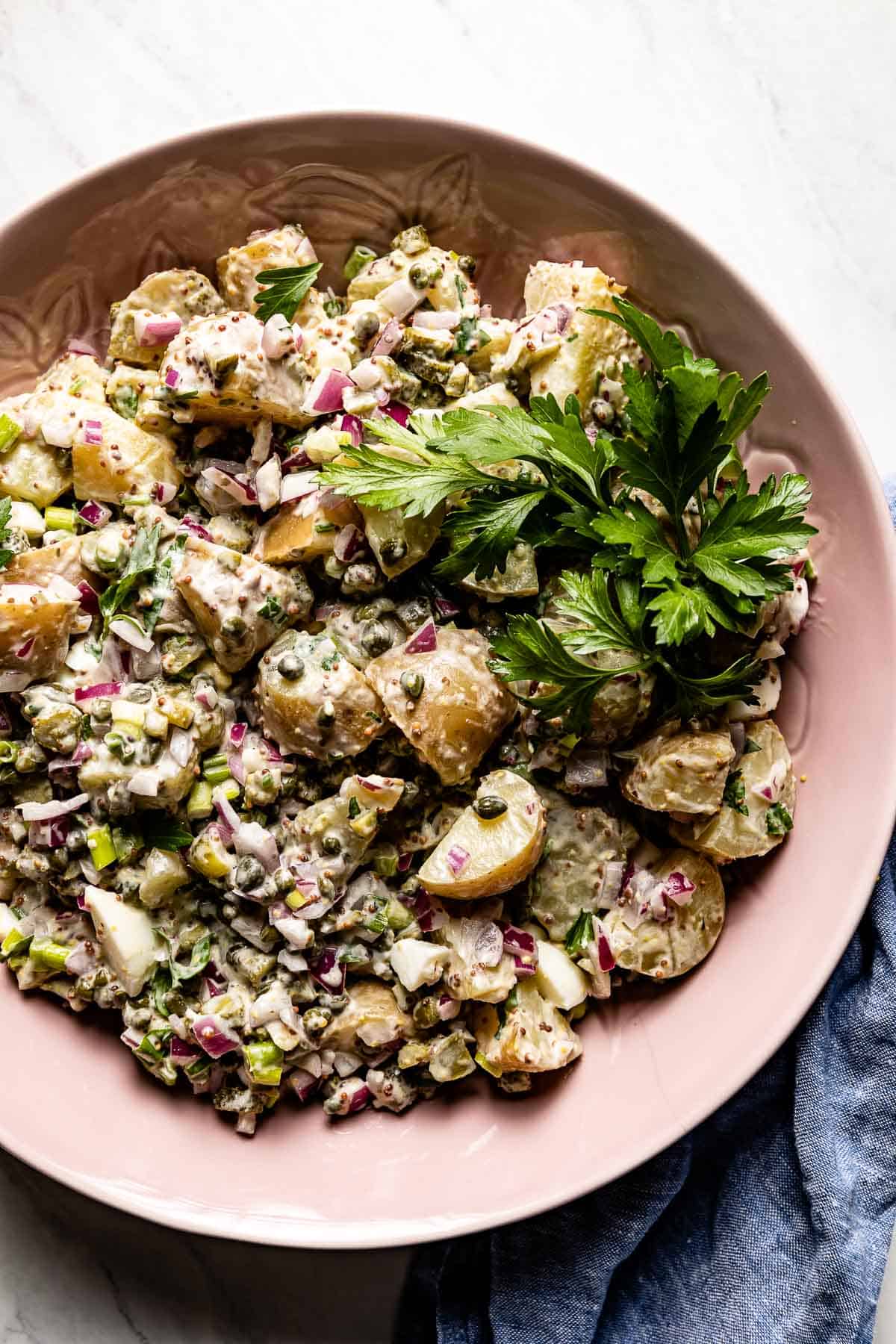Also known as “dolphin fish,” mahi mahi is a majorly versatile ingredient. With its mild flavor and tender texture, this Hawaiian fish is a blank canvas that you can season and cook in dozens of different ways. Pan-fry, oven-bake, or prepare it on the grill (i.e., my Grilled Mahi Mahi recipe complete with my fan-favorite Mahi Mahi Marinade!), and you’ll never run out of ideas for an easy weeknight dinner.
Love blackened fish? Be sure to also try our Blackened Cod recipe.
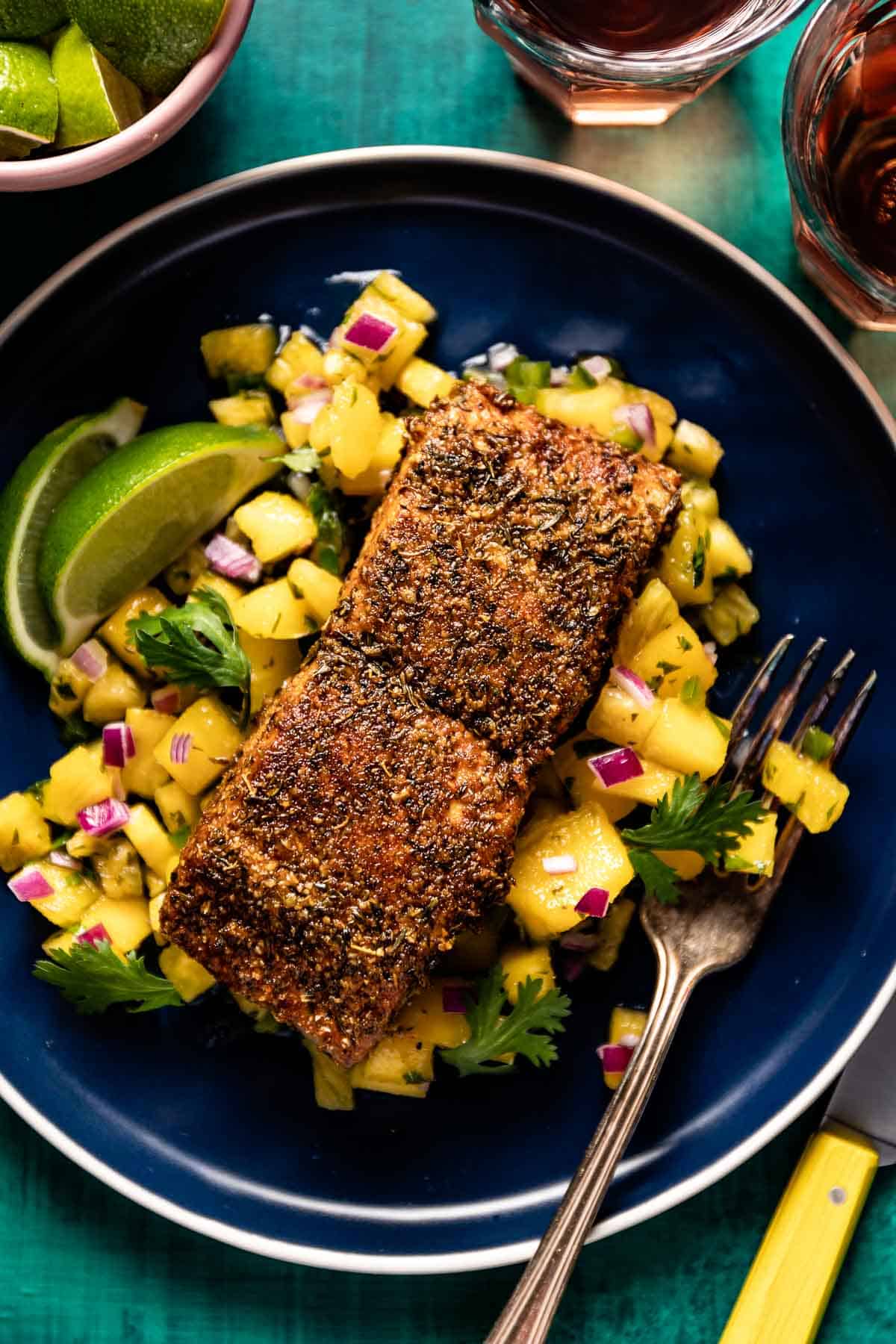
This Blackened version is inspired by the cult favorite Costco blackened mahi mahi. Once you master the easy steps to making it at home, you won’t have to buy it from the store ever again.
Ingredients You’ll Need
You only need a few fresh, simple ingredients to prepare this blackened mahi mahi recipe:
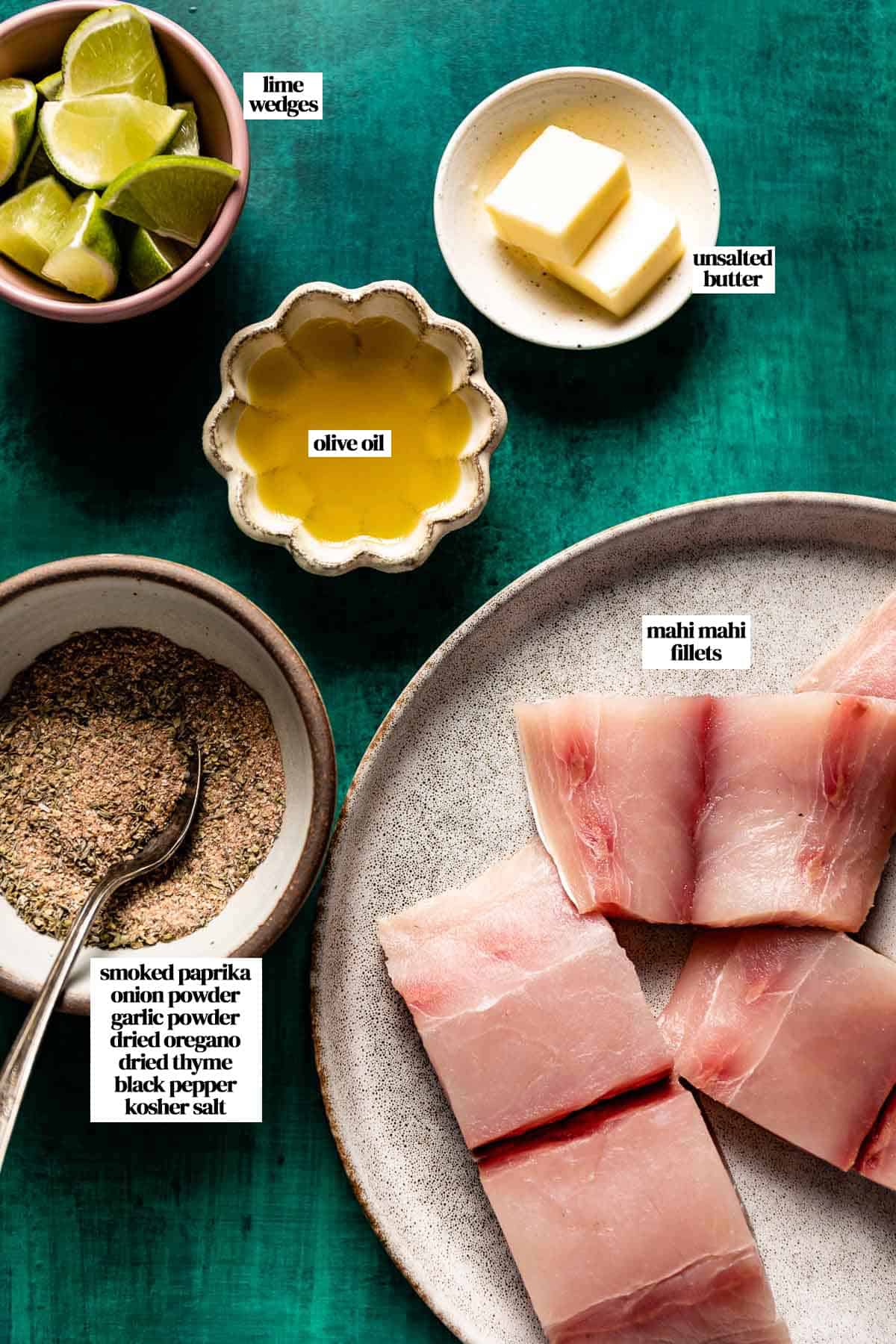
- Mahi Mahi: If you can get your hands on them, use fresh mahi mahi filets. However, frozen mahi mahi would also work. If you use frozen filets (pre-cut slices), thaw them overnight in the fridge or place them in a bowl of cold water, store them in the refrigerator, and wait until it thaws fully (1-2 hours). If you purchase a whole mahi mahi, I suggest cutting it into evenly sized portions. You also have the choice to prepare this dish as a skin-on mahi mahi recipe or remove the skin before cooking.
- Olive oil: I use olive oil to brush the mahi mahi steaks, but you can use any oil with a high smoke point, such as canola, grapeseed, or avocado oil.
- Unsalted Butter: Searing the fish in butter is the key to giving this recipe a rich, sumptuous taste. However, you may substitute it with olive oil if you are following a dairy-free diet.
- Lemon or lime: I love topping this seafood dish with a squeeze of fresh lemon juice to brighten its natural flavors. However, you can also prepare this mahi mahi recipe without lemon juice by using lime juice instead or omitting the ingredient entirely.
- Mahi mahi seasoning: In my opinion, the best seasoning for mahi mahi is my Homemade Blackened Seasoning, which uses a classic Louisianian mix of spices:
- Paprika: Though I prefer smoked paprika for this seafood recipe, regular paprika will also work.
- Onion powder
- Garlic powder
- Dried oregano
- Dried thyme
- Black pepper
- Kosher salt: Salt is a simple, pantry-ready ingredient that helps add depth to your blackened seasoning for mahi mahi. However, you can omit this ingredient if you’re watching your sodium intake or prefer a less salty version.
If you don’t have these spices for mahi mahi on hand, I recommend using Old Bay Blackened Seasoning (affiliate link) as an easy, store-bought substitute.
How to Make Blackened Mahi Mahi?
My favorite way to blacken mahi mahi on a busy weeknight is using a cast iron skillet. However, you can also use a frying pan or a nonstick skillet. Follow these easy instructions for perfectly blackened fish filets any night of the week.

- Dry the mahi mahi: Use a paper towel to pat dry the fish fillets on both sides.
- Brush with olive oil: Lightly coat both sides of the mahi mahi with olive oil, then set aside.
- Prepare the seasoning for mahi mahi: Gather a shallow baking dish or a large plate. Then, mix the smoked paprika, onion powder, garlic powder, dried oregano, dried thyme, ground black pepper, and Kosher salt, ensuring that the spices blend evenly.
- Season the mahi-mahi fillets: Dredge each piece of fish in the dry rub until you coat both sides. Set the seasoned steaks aside.
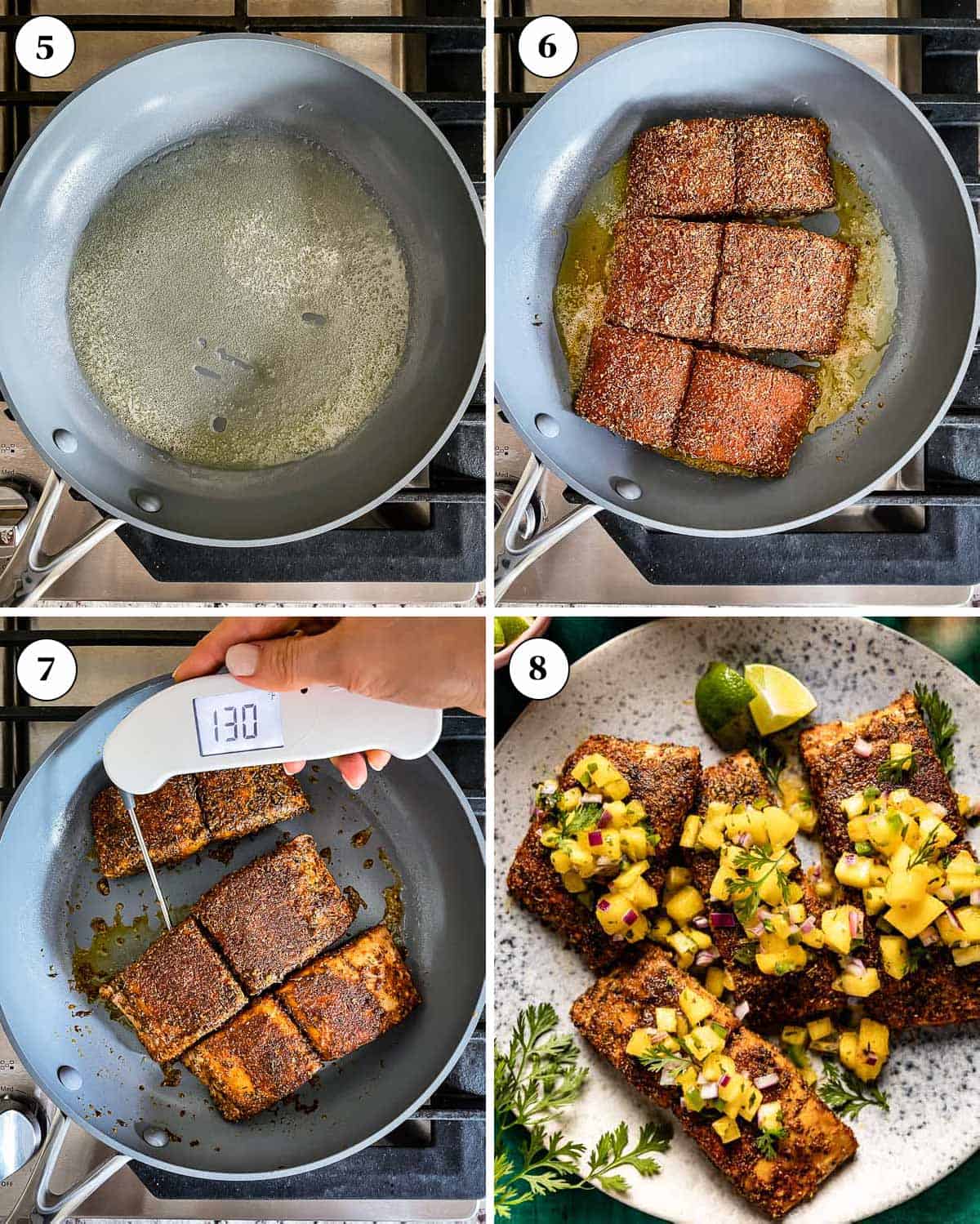
- Melt butter: Heat a cast-iron skillet or frying pan over medium-high heat. Add the butter to the skillet and cook until entirely melted.
- Add the mahi mahi: Gently transfer the seasoned fish to the hot pan, ensuring you don’t overcrowd it. You can cook this recipe in two batches if your fish doesn’t fit.
- Cook the fish: Cook the mahi mahi steaks for two minutes. Then, flip them over and cook on the opposite side for another two minutes. Try to flake a small piece of the filet to test for doneness. If it flakes easily and is opaque, it’s ready to serve. If not, cook for 30 seconds on each side until done. Your mahi mahi should reach an internal temperature of 130 degrees F. before eating.
- Serve: Remove the mahi mahi from the cast iron skillet and cover with aluminum foil. Let the fish rest for a few minutes, then serve with lemon/lime wedges. Garnish with my pineapple mango salsa, if desired.
How to Grill Blackened Dolphin Fish?
Grilling blackened mahi mahi is a breeze when you use these simple instructions. In a total time of 15 minutes, you’ll have the ultimate summer dish ready to serve.
- Preheat: Set the grill to medium-high heat and wait until it reaches 425 degrees F.
- Prep the grill: Clean off previous food debris from the grill. Then, use tongs to dip a wad of paper towel into the oil and generously coat the cooking surface of the grates.
- Cook the mahi mahi: Lay the seasoned filets on the grill, place the cover on, and grill for two minutes. Use a good fish spatula to gently flip each steak, then grill for another two minutes. Use a digital thermometer to check the internal temperature of the mahi mahi steaks. When they reach 130 degrees F., remove them from the grill.
- Serve: Transfer the mahi mahi steaks from the grill to a plate. Cover them with aluminum foil and let them rest for a few minutes. Serve!
How to Store and Reheat?
There’s no denying that this Cajun mahi mahi recipe tastes best when served fresh. However, with these storage tips, you can keep your leftovers fresh for quick lunches and easy meal prep.
- Store: Let your leftover mahi mahi filet reach room temperature before transferring it to an airtight container. Then, store it in the fridge, and your blackened fish will stay fresh for up to two days.
- Reheat: To reheat your Cajun mahi mahi, place it in the oven at low heat (300 degrees F.) for 3-4 minutes. Because this fish can dry out quickly, keep an eye on it during the warming process.
What to Serve with this Recipe?
Look no further if you’re looking for an Instagram-ready main course guaranteed to satisfy your tastebuds. Transform your fish filet into a sophisticated mahi mahi dinner with these tasty sides.
- Fruity salsa: Who can resist a pairing that’s both iconic and colorful? Top your filets with Peach Salsa or Mango Pineapple Salsa to balance out the bold spice of blackened mahi mahi seasoning with luscious, sweet flavors.
- Make tacos: Everyone loves Blackened Mahi Mahi Tacos’ fresh, bright taste. Skip the grocery store with my easy recipe for Corn Tortillas. Then, customize your fish tacos with delicious toppings, like my Easy Guacamole, Avocado Crema, and Mayo and Sugar Free Coleslaw.
- With corn: Add sweet, tender veggies to your plate with mouthwatering corn recipes. Transform your table into an authentic Mexican market with my zesty recipes for Street Corn and Mexican Street Corn Salad. Or, give your menu a rustic, golden-yellow touch by preparing Air Fryer Corn on the Cob.
- Rice: This spicy Cajun recipe tastes out-of-this-world when served atop a bed of fresh, steaming white rice. My favorites are simple basmati and coconut rice, which take minutes to prepare. However, you can also take your rice game to the next level by preparing low-carb, lime-infused coconut cauliflower rice.
- Vegetables: Balance your hearty mahi mahi steaks with a light, healthy veggie side. My Buttery Garlic Beans give a rich, seasoned flavor to each bite. You can also take the hassle out of meal prep with 10-minute Air Fryer Green Beans or Steamed Asparagus.
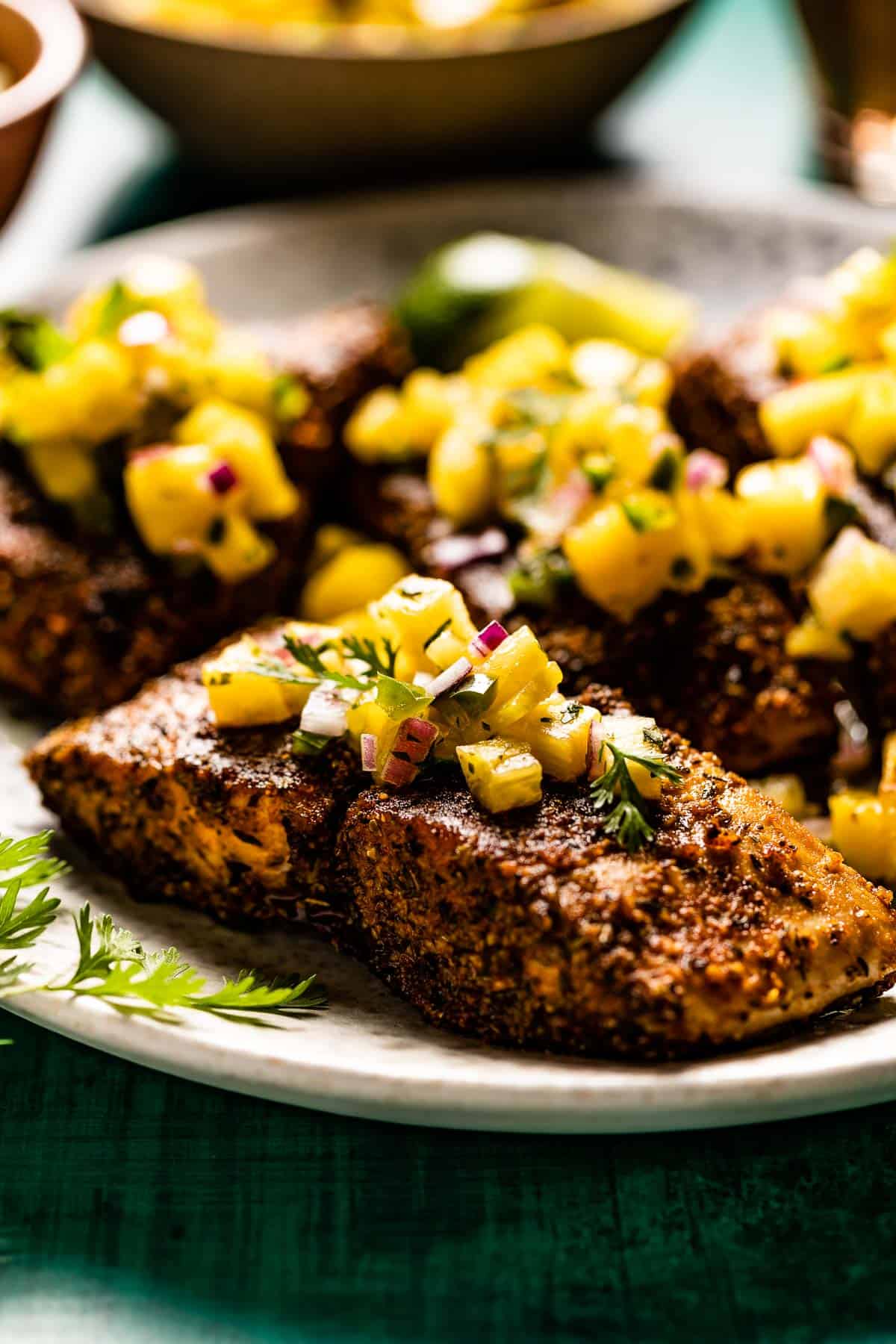
Expert Tips
While I think that this is the best way to cook mahi mahi, below are a few things to keep in mind when making this recipe:
- Thaw if frozen: If you use frozen mahi mahi steaks, be sure to thaw them fully before cooking. One option is to thaw them in the fridge or overnight. Otherwise, you can thaw them in 1-2 hours by placing them in a bowl of cold water and transferring the bowl to the fridge until ready to cook.
- Timing: Cooking times may vary based on the size and thickness of your mahi mahi filets, so keep an eye on your fish to avoid over or undercooked pieces. If possible, purchase fish fillets that are equal in size to ensure even cooking.
- Seasoned skillet: The best way to keep your mahi mahi from sticking to the pan is to use a well-seasoned cast iron skillet. Not only will this allow your filets to come off the pan in one piece, but it will also give your fish a deliciously complex flavor profile. If you feel uncomfortable cooking blackened mahi mahi in a cast iron skillet, a ceramic frying pan (affiliate link) is a great option.
- High heat: The best tip for making this quick mahi mahi recipe is to fully heat your pan or grill before adding your meat. This high temperature will ensure a short cooking time, keep your fish moist, and—if you don’t touch your filets during the cooking process—will ensure they don’t break apart when flipping them.
- Dry the fish and season well: If you want every bite of this blackened mahi mahi recipe to have maximum flavor, fully dry and add the blackened seasoning mix to all sides of the fish—not just the top and bottom. I also recommend gently pushing the seasoning into the meat so it doesn’t fall off during cooking.
- Keep a close eye on it: Mahi mahi cooks incredibly quickly, so watch it closely throughout the process to ensure it doesn’t overcook.
- Rest for a few minutes: After removing them from the heat, let your blackened fish filets rest under an aluminum foil tent for 1-2 minutes. This step will allow your mahi mahi to reabsorb its flavorful juices, resulting in a juicy, tender fish.
- Proper ventilation: This recipe uses many aromatic spices, so it tends to smoke when placed on a high-heat grill or cast-iron skillet. I recommend preparing this dish in a well-ventilated area to avoid coughing or discomfort, using a kitchen fan or open windows.
FAQs
You don’t have to stress over this quick mahi mahi recipe. These expert answers will eliminate all your cooking worries, from oven-baked alternatives to adjusting spice levels.
If you’re wondering, “What is blackened mahi mahi?” you’re not alone! “Blackening” is a process in which something—usually a protein—is pat-dry, brushed with melted butter or oil, and heavily coated in a Cajun seasoning blend. The fish is then cooked at a high temperature until it forms a crispy crust of external seasoning.
To make oven-baked blackened mahi mahi, preheat your oven to 375 degrees F. Then, cook your seasoned filets for 8-10 minutes or until they reach an internal temperature of 130 degrees F.
Blackened mahi mahi boasts one of my recipe book’s most balanced flavor profiles. Its bold seasoning gives it a smoky, savory, and spicy kick, while the fish provides a mild and sweet base.
Yes, you can. Other firm and mild white fish, such as halibut, grouper, and snapper, would also work.
Though blackened fish is mildly spicy, the level of spiciness may vary depending on the rub used for mahi mahi. Specific blackened seasoning mixes may use more cayenne pepper than others, producing a spicier taste. Make your own blackening seasoning mix so you can adjust the spiciness according to your taste buds.
Other Fish Recipes You Might Also Like
Can’t get enough of this mahi mahi with homemade Cajun seasoning? These other fish dishes will give you fresh coastal vibes, satisfying your seafood cravings with tender, buttery flavors.
If you try this Blackened Mahi Mahi recipe or any other recipe on Foolproof Living, please take a minute to rate the recipe and leave a comment below. It is a great help to others who are thinking of making the recipe. And if you took some pictures, be sure to share them on Instagram using #foolproofeats so I can share them on my stories.
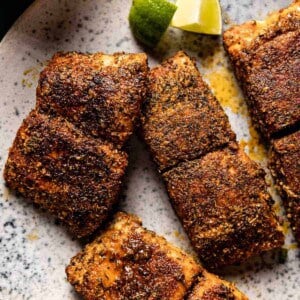
Blackened Mahi Mahi Recipe
Ingredients
- 4 mahi mahi filets, 4 ounces each – thawed if frozen
- 2 tablespoons olive oil, plus more if grilling
- 2 tablespoons unsalted butter
Blackened seasoning:
- 3 teaspoons smoked paprika
- 2 teaspoon onion powder
- 2 teaspoon garlic powder
- 2 teaspoons dried oregano
- 2 teaspoons dried thyme
- 2 teaspoons ground black pepper
- 1 teaspoon Kosher salt
Optional:
- ¼ teaspoon Cayenne pepper, (optional)
- Lemon, or lime wedges
Instructions
- Prepare the mahi mahi fillets: Pat the filets dry on both sides with using a few sheets of paper towels.
- Lightly brush the fillets with olive oil on both sides. Set aside.
- Make the blackened seasoning by mixing together the smoked paprika, onion powder, garlic powder, dried oregano, dried thyme, ground black pepper, and Kosher salt in a shallow baking dish or large plate. Make sure that it is fully blended.
- Dredge each mahi mahi filet in the blackened seasoning, making sure that they are coated on both sides. Set aside.
- To blacken mahi mahi on the stove, start by heating a cast iron skillet (or a frying pan) over medium-high heat.
- Add the butter and cook until fully melted but not browned.
- Gently add the seasoned mahi mahi fillets to the pan. Do not overcrowd the pan. If all four of them don’t fit, you can do it in two batches.
- Cook for 2 minutes, then gently flip and continue to cook the other side for an additional 2 minutes. To test for doneness, try to flake a small area of the fish. It should flake easily and look opaque. If it does not, cook for an additional 30 seconds per side until done. If you have a digital thermometer, you can insert it into the thickest part of the fish. If it registers 130 degrees F, it should be cooked.
- Remove from the skillet, cover it with aluminum foil, and let your blackened mahi mahi rest for a few minutes. Serve with lime or lemon wedges on the side. If preferred, garnish with mango salsa.
Notes
- Yields: This recipe makes 4 blackened mahi mahi fillets and serves 4 people.
- Timing: Cooking times may vary based on the size and thickness of your mahi mahi filets, so keep an eye on your fish to avoid over or undercooked pieces. If possible, purchase fish fillets that are equal in size to ensure even cooking.
- Seasoned skillet: The best way to keep your mahi mahi from sticking to the pan is to use a well-seasoned cast iron skillet. A ceramic frying pan (affiliate link) is a great option if you do not have a cast iron skillet.
- Keep a close eye on it: Mahi mahi cooks very quickly, so it is recommended that you watch it closely as it cooks.
- Storage of leftovers: Let your leftover mahi mahi filet reach room temperature before transferring it to an airtight container. Then, store it in the fridge for up to two days.
- To Cook Blacken Mahi Mahi on the grill:
- Heat a grill to medium-high until it reaches 425 degrees F.
- Prepare the grill by cleaning off any previous food debris. Using tongs, dip a wad of paper towel into the oil and generously coat the grates where you will be cooking the filets.
- Gently place the mahi mahi steaks on the grill. Put the cover on and grill for 2 minutes. Using a spatula, carefully flip them and grill for another 2 minutes. If you have a digital thermometer, you can check doneness by inserting it into one of the fillets. The internal temperature should be 130 degrees F.
- Remove from the grill onto a plate. Cover with foil and let them rest for a few minutes before serving.
Nutrition
Nutrition information is automatically calculated, so should only be used as an approximation.

